| Click here for Home Page to see List of All My Trips and Three Methods to search my Travelogue website for web pages of interest to you |
| Huge Fields of Solar Power Panels and of Wind Turbines In Southern California |
Palm Springs is about 120 miles southeast of Los Angeles. In touring various points of interest in southeast
California in the last week of October 2006, when we were traveling on Interstate Highway I-10 or on Highway
62 near Palm Springs, we were delightfully surprised to see a huge forest of modern gigantic wind turbines
spreading over very large areas at San Gorgonio Pass as shown on this web page.
Map: Click here to see Google Map showing Highway I-10 and Highway 62 near Palm Springs
California in the last week of October 2006, when we were traveling on Interstate Highway I-10 or on Highway
62 near Palm Springs, we were delightfully surprised to see a huge forest of modern gigantic wind turbines
spreading over very large areas at San Gorgonio Pass as shown on this web page.
Map: Click here to see Google Map showing Highway I-10 and Highway 62 near Palm Springs
Huge area of modern windmill farm near Palm Springs in southern California
It was an absolutely wonderful experience for me to see such huge arrays of towers of gigantic wind turbines,
of so many solar tracking mirrors and of so many solar panels spreading over such big areas in southern
California to generate electric power from the clean and sustainable energy sources of wind and sun.
Decreasing Cost of Renewable Energy:
The following article entitled "Low Costs of Solar Power & Wind Power Crush Coal, Crush Nuclear, & Beat
Natural Gas" and dated December 25th, 2016 by Zachary Shahan provides comparison of costs of wind power
and solar power relative to those of coal, nuclear and natural gas:
https://cleantechnica.com/2016/12/25/cost-of-solar-power-vs-cost-of-wind-power-coal-nuclear-natural-gas/
Some people still believe that the renewable energy is always slightly more expensive than those of traditional
power plants that burn coals or other fossil fuels. However, even if the renewable green energy is slightly more
expensive, such extra cost is still worthwhile because the green energy gives us much cleaner air and
environment which are good for our health.
Health Impacts of Heavy Air Pollution
Many photos of heavy air pollution in many cities in developing countries can be seen here. Air pollution levels
in such cities at times are up to 30 times greater than those found in highly developed countries. Sometimes,
the air pollution in such cities are so heavy such that if somebody punched you in the face, you could not even
see who punched you. Residents in such highly polluted cities have reportedly been queuing up to buy face
masks and there is even a shortage of face mask in such cities. Toxic smog closes schools in such heavily
polluted cities.
The air pollution includes NOT just regular smog. TOXIC HEAVY METALS can also become airborne. This
includes extremely dangerous ones like cadmium, lead and mercury. We breathe them in and they enter our
bloodstream. Those poisonous substances can do deep damage to various cells, organs and immune system
in our body.
According to the statistics from World Health Organization (WHO), ambient (outdoor) air pollution accounts for
an estimated 4.2 million deaths per year due to stroke, heart disease, lung cancer and chronic respiratory
diseases.
The life expectancies of people living in developing countries with heavily polluted air and environment are
mostly shorter by 10 years or more than those in highly developed countries with clean air and clean
environment.
This is a good motivation to use clean and renewable energy sources such as wind turbine farm or solar panel
farm instead of the dirty fossil fuels for electric power generation.
Increasing Percentage of Renewable Energy:
For people interested in renewable energy, it is worthwhile to read the following article dated June 7, 2017
from The New York Times entitled
"Renewable energy push is strongest in the reddest states"
at:
http://www.cnbc.com/2017/06/07/renewable-energy-push-is-strongest-in-the-reddest-states.html
The highlights of this article are:
Kansas blew past that 20 percent target in 2014, and last year it generated more than 30 percent of its power
from wind. The state may be the first in the country to hit 50 percent wind generation in a year or two, unless
Iowa gets there first.
"We export lots of things, and in our future, I want us to export a lot of wind power," Kansas' conservative
Republican governor, Sam Brownback, declared in a speech in 2011. "We need more of it, and we need more
of it now." Mr. Brownback got what he wanted: Since he spoke, wind power production in Kansas has nearly
tripled, and the state is now an exporter of clean electricity. Kansas alone could, in theory, supply a majority of
the nation's electricity using wind turbines
(In that 2011 Speech, Kansas governor, Sam Brownback said that wind power in Kansas can generate
electric power that is 90 times the need of electric power in Kansas.)
puts steady money in the hands of farmers who host wind turbines in Kansas, (the same piece of land can be
used both for farming and for wind power generation to get more incomes for the farmers.)
The five states that get the largest percentage of their power from wind turbines — Iowa, Kansas, South
Dakota, Oklahoma and North Dakota , (the windy Great Plains states.)
Texas produces the most wind power in absolute terms.
Would allow more renewable energy generated in the red states to flow to California consumers — and move
California money into the pockets of red-state landowners.
Analysts have found that most states are on track to meet their targets, usually well ahead of schedule.
New York and California are redoubling their own efforts. Both states have resolved to get 50 percent of their
power from renewable energy, and California is debating whether to set a target of 100 percent by 2045.
Questions and Solutions for Wind Power and Solar Power:
Some people ask the following questions on the limitations of wind power and solar power:
Q1: How to generate wind power when there is no wind?
Q2: How to generate solar power in the night or on raining days?
The possible solutions to handle such limitations of wind power and solar power are:
1. The huge amount of excess wind power in the Windy Great Plain States and the power shortage in coastal
states with more money provide incentive to upgrade the nationwide electric power transmission network so
that the design and the operation of the nationwide electric power transmission network will be smarter to
move the excess power from one geographic region with excess power to a region with power shortage.
Therefore, with such adaptive, dynamic and intelligent nationwide electric transmission network, excess power
can move more easily from windy regions to regions with no wind, and can move from regions with strong
sunshine to regions with no sunshine.
2. As an example, the large Merrill Creek Reservoir on a mountain in western New Jersey has been used
jointly by several electric power utility companies as a large reservoir for storage of excess energy. During the
periods of excess power, they use the excess power to pump a lot of water from the river up the mountain and
into the Merrill Creek Reservoir to store the excess energy. During the periods with shortage of power, they let
the water flows through a big pipe down the mountain to drive one or more hydro-electric turbines to generate
the needed electric power. In other words, a huge reservoir of water on a mountain can be used as a huge
rechargeable battery to store excess energy. In Hawaii, plans are already being drawn up for advanced
pumped storage hydropower plants that deftly flip between charge and discharge to balance shifting wind or
solar power.
3. By having a suitable set of large water reservoirs on mountains at suitable locations to store a lot of excess
energy plus the adaptive and intelligent nationwide electric power transmission network, the limitations Q1 and
Q2 of wind power and solar power can be solved easily.
4. Progress in Battery Technology for Clean and Renewable Energy
In last 40 years, the wind turbine technology and solar power technology have gone through several
generations of improvements and cost reduction to make them cost effective, reliable and practical.
However, one serious obstacle is the weather. The electric power generated from a wind turbine farm may not
be reliable because there is no wind in certain time period. Similarly, the electric power generated from a solar
farm may not be reliable because it may be at night with no sun or it may be a raining day or a snowing day
with no sun. So, cost effective storage of energy for use during “bad” weather conditions has been an
important issue for such clean and renewable energy systems.
Fortunately, cost effective solution for this issue is available now as described below.
New forms of lower cost electricity storage are making the electric power grid more renewable, more reliable,
cleaner and at lower cost.
"This will be like the change from analog to digital, or landlines to cell phones,” says Advanced Microgrid
Systems CEO Susan Kennedy, whose firm’s software helps utilities optimize their power choices every instant
of every day. “The energy industry will never be the same.”
According to the survey data from BloombergNEF (Bloomberg New Energy Finance Limited Company), the
cost of lithium-ion batteries has plunged 85 percent in a decade, and 30 percent in just the past year (2018).
Two strong driving forces for this downward cost trend come from the transitions in the automotive industry
away from dirty internal combustion engine vehicles into clean electric vehicles and in electric power markets
away from dirty fossil fuels into clean and renewable energy sources, such as wind power and solar power.
With lower cost storage batteries, electric utility companies across the U.S. have started attaching containers
full of lithium-ion batteries to the electric power grid—and they’re planning to install far more of them in the
coming years. Electricity has always been the toughest commodity to manage, because unlike water, grain,
fuel or steel, historically electric power has been largely very difficult and expensive to store for later use. But
that is changing fast, and even though the dramatic growth of batteries on the grid will be invisible to most
Americans, it has the potential to transform how we produce and consume power, creating more flexible and
resilient electricity systems with less waste, lower costs and fewer pollution emissions.
Thanks to the dizzying cost declines, utilities are now building new wind and solar farms accompanied by new
battery storage for less than they would pay to build new fossil-fuel electricity generation plants—and in some
cases less than they would pay to run existing fossil-fuel plants. Pairing renewable electric energy sources with
battery storage lets electric power grid operators fill in gaps when the weather isn’t cooperating and dispatch
power in more predictable ways when it’s needed most
Jigar Shah, the founder of the pioneering solar company Sun Edison and now the president of the clean energy
finance firm Generate Capital, believes hundreds of billions of dollars worth of fossil-fueled peaker pollution
plants that often run just a few hundred hours a year might soon be mothballed for good.
Southwest Power Pool in USA now routinely handles 50 percent and even 60 percent of electric power
generation from wind while keeping the lights on without interruption. There was one afternoon last month when
California’s grid was receiving more than two-thirds of its power from solar with no reliability problems at all.
Sample references for such rapid trend of cost reduction in energy storage batteries can be seen here and
here.
For longer term future, in addition to the rapid reduction in the cost of lithium-ion battery, other new energy
storage technologies may become mature and available that may further lower the cost of energy storage.
of so many solar tracking mirrors and of so many solar panels spreading over such big areas in southern
California to generate electric power from the clean and sustainable energy sources of wind and sun.
Decreasing Cost of Renewable Energy:
The following article entitled "Low Costs of Solar Power & Wind Power Crush Coal, Crush Nuclear, & Beat
Natural Gas" and dated December 25th, 2016 by Zachary Shahan provides comparison of costs of wind power
and solar power relative to those of coal, nuclear and natural gas:
https://cleantechnica.com/2016/12/25/cost-of-solar-power-vs-cost-of-wind-power-coal-nuclear-natural-gas/
Some people still believe that the renewable energy is always slightly more expensive than those of traditional
power plants that burn coals or other fossil fuels. However, even if the renewable green energy is slightly more
expensive, such extra cost is still worthwhile because the green energy gives us much cleaner air and
environment which are good for our health.
Health Impacts of Heavy Air Pollution
Many photos of heavy air pollution in many cities in developing countries can be seen here. Air pollution levels
in such cities at times are up to 30 times greater than those found in highly developed countries. Sometimes,
the air pollution in such cities are so heavy such that if somebody punched you in the face, you could not even
see who punched you. Residents in such highly polluted cities have reportedly been queuing up to buy face
masks and there is even a shortage of face mask in such cities. Toxic smog closes schools in such heavily
polluted cities.
The air pollution includes NOT just regular smog. TOXIC HEAVY METALS can also become airborne. This
includes extremely dangerous ones like cadmium, lead and mercury. We breathe them in and they enter our
bloodstream. Those poisonous substances can do deep damage to various cells, organs and immune system
in our body.
According to the statistics from World Health Organization (WHO), ambient (outdoor) air pollution accounts for
an estimated 4.2 million deaths per year due to stroke, heart disease, lung cancer and chronic respiratory
diseases.
The life expectancies of people living in developing countries with heavily polluted air and environment are
mostly shorter by 10 years or more than those in highly developed countries with clean air and clean
environment.
This is a good motivation to use clean and renewable energy sources such as wind turbine farm or solar panel
farm instead of the dirty fossil fuels for electric power generation.
Increasing Percentage of Renewable Energy:
For people interested in renewable energy, it is worthwhile to read the following article dated June 7, 2017
from The New York Times entitled
"Renewable energy push is strongest in the reddest states"
at:
http://www.cnbc.com/2017/06/07/renewable-energy-push-is-strongest-in-the-reddest-states.html
The highlights of this article are:
Kansas blew past that 20 percent target in 2014, and last year it generated more than 30 percent of its power
from wind. The state may be the first in the country to hit 50 percent wind generation in a year or two, unless
Iowa gets there first.
"We export lots of things, and in our future, I want us to export a lot of wind power," Kansas' conservative
Republican governor, Sam Brownback, declared in a speech in 2011. "We need more of it, and we need more
of it now." Mr. Brownback got what he wanted: Since he spoke, wind power production in Kansas has nearly
tripled, and the state is now an exporter of clean electricity. Kansas alone could, in theory, supply a majority of
the nation's electricity using wind turbines
(In that 2011 Speech, Kansas governor, Sam Brownback said that wind power in Kansas can generate
electric power that is 90 times the need of electric power in Kansas.)
puts steady money in the hands of farmers who host wind turbines in Kansas, (the same piece of land can be
used both for farming and for wind power generation to get more incomes for the farmers.)
The five states that get the largest percentage of their power from wind turbines — Iowa, Kansas, South
Dakota, Oklahoma and North Dakota , (the windy Great Plains states.)
Texas produces the most wind power in absolute terms.
Would allow more renewable energy generated in the red states to flow to California consumers — and move
California money into the pockets of red-state landowners.
Analysts have found that most states are on track to meet their targets, usually well ahead of schedule.
New York and California are redoubling their own efforts. Both states have resolved to get 50 percent of their
power from renewable energy, and California is debating whether to set a target of 100 percent by 2045.
Questions and Solutions for Wind Power and Solar Power:
Some people ask the following questions on the limitations of wind power and solar power:
Q1: How to generate wind power when there is no wind?
Q2: How to generate solar power in the night or on raining days?
The possible solutions to handle such limitations of wind power and solar power are:
1. The huge amount of excess wind power in the Windy Great Plain States and the power shortage in coastal
states with more money provide incentive to upgrade the nationwide electric power transmission network so
that the design and the operation of the nationwide electric power transmission network will be smarter to
move the excess power from one geographic region with excess power to a region with power shortage.
Therefore, with such adaptive, dynamic and intelligent nationwide electric transmission network, excess power
can move more easily from windy regions to regions with no wind, and can move from regions with strong
sunshine to regions with no sunshine.
2. As an example, the large Merrill Creek Reservoir on a mountain in western New Jersey has been used
jointly by several electric power utility companies as a large reservoir for storage of excess energy. During the
periods of excess power, they use the excess power to pump a lot of water from the river up the mountain and
into the Merrill Creek Reservoir to store the excess energy. During the periods with shortage of power, they let
the water flows through a big pipe down the mountain to drive one or more hydro-electric turbines to generate
the needed electric power. In other words, a huge reservoir of water on a mountain can be used as a huge
rechargeable battery to store excess energy. In Hawaii, plans are already being drawn up for advanced
pumped storage hydropower plants that deftly flip between charge and discharge to balance shifting wind or
solar power.
3. By having a suitable set of large water reservoirs on mountains at suitable locations to store a lot of excess
energy plus the adaptive and intelligent nationwide electric power transmission network, the limitations Q1 and
Q2 of wind power and solar power can be solved easily.
4. Progress in Battery Technology for Clean and Renewable Energy
In last 40 years, the wind turbine technology and solar power technology have gone through several
generations of improvements and cost reduction to make them cost effective, reliable and practical.
However, one serious obstacle is the weather. The electric power generated from a wind turbine farm may not
be reliable because there is no wind in certain time period. Similarly, the electric power generated from a solar
farm may not be reliable because it may be at night with no sun or it may be a raining day or a snowing day
with no sun. So, cost effective storage of energy for use during “bad” weather conditions has been an
important issue for such clean and renewable energy systems.
Fortunately, cost effective solution for this issue is available now as described below.
New forms of lower cost electricity storage are making the electric power grid more renewable, more reliable,
cleaner and at lower cost.
"This will be like the change from analog to digital, or landlines to cell phones,” says Advanced Microgrid
Systems CEO Susan Kennedy, whose firm’s software helps utilities optimize their power choices every instant
of every day. “The energy industry will never be the same.”
According to the survey data from BloombergNEF (Bloomberg New Energy Finance Limited Company), the
cost of lithium-ion batteries has plunged 85 percent in a decade, and 30 percent in just the past year (2018).
Two strong driving forces for this downward cost trend come from the transitions in the automotive industry
away from dirty internal combustion engine vehicles into clean electric vehicles and in electric power markets
away from dirty fossil fuels into clean and renewable energy sources, such as wind power and solar power.
With lower cost storage batteries, electric utility companies across the U.S. have started attaching containers
full of lithium-ion batteries to the electric power grid—and they’re planning to install far more of them in the
coming years. Electricity has always been the toughest commodity to manage, because unlike water, grain,
fuel or steel, historically electric power has been largely very difficult and expensive to store for later use. But
that is changing fast, and even though the dramatic growth of batteries on the grid will be invisible to most
Americans, it has the potential to transform how we produce and consume power, creating more flexible and
resilient electricity systems with less waste, lower costs and fewer pollution emissions.
Thanks to the dizzying cost declines, utilities are now building new wind and solar farms accompanied by new
battery storage for less than they would pay to build new fossil-fuel electricity generation plants—and in some
cases less than they would pay to run existing fossil-fuel plants. Pairing renewable electric energy sources with
battery storage lets electric power grid operators fill in gaps when the weather isn’t cooperating and dispatch
power in more predictable ways when it’s needed most
Jigar Shah, the founder of the pioneering solar company Sun Edison and now the president of the clean energy
finance firm Generate Capital, believes hundreds of billions of dollars worth of fossil-fueled peaker pollution
plants that often run just a few hundred hours a year might soon be mothballed for good.
Southwest Power Pool in USA now routinely handles 50 percent and even 60 percent of electric power
generation from wind while keeping the lights on without interruption. There was one afternoon last month when
California’s grid was receiving more than two-thirds of its power from solar with no reliability problems at all.
Sample references for such rapid trend of cost reduction in energy storage batteries can be seen here and
here.
For longer term future, in addition to the rapid reduction in the cost of lithium-ion battery, other new energy
storage technologies may become mature and available that may further lower the cost of energy storage.







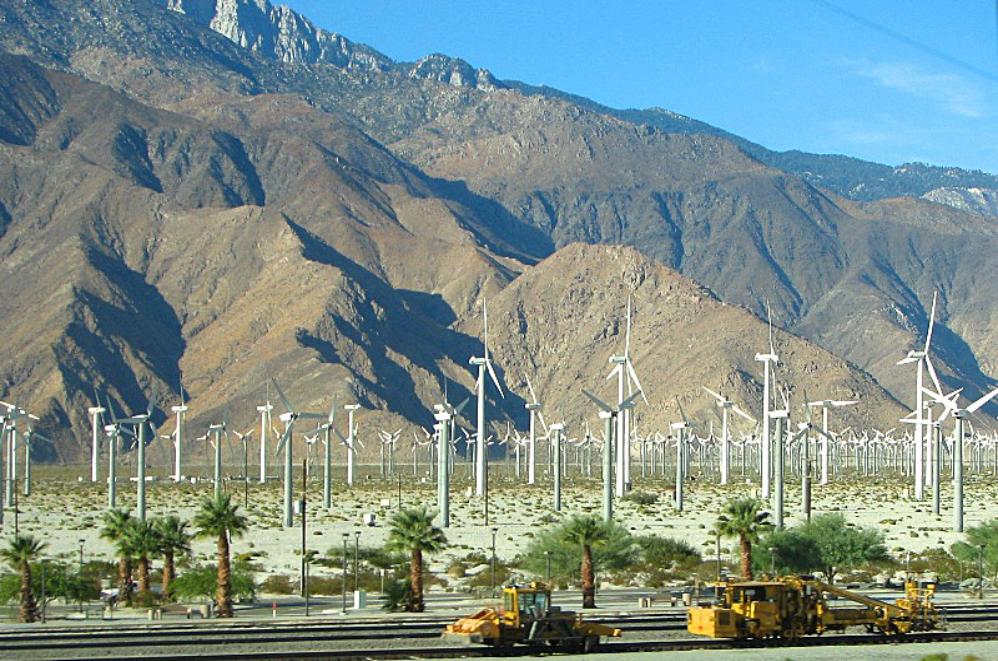

In case if you see overlapped lines of text or some lines of text become obscured behind a picture on this web
page, please change the page magnification (zoom) factor to eliminate such problems by pressing these two
keys "Ctrl +" simultaneously or these two keys "Ctrl -" simultaneously. Depending on your PC setting, it may be
necessary to reduce the magnification factor several steps down in order to eliminate the overlap and
obstructed text lines.
Please press the F11 key (Fn key and F11 key on laptop PC) on your keyboard to get full-screen view of
photos and web page. Pressing F11 key again will return to your normal screen with various tool bars.
page, please change the page magnification (zoom) factor to eliminate such problems by pressing these two
keys "Ctrl +" simultaneously or these two keys "Ctrl -" simultaneously. Depending on your PC setting, it may be
necessary to reduce the magnification factor several steps down in order to eliminate the overlap and
obstructed text lines.
Please press the F11 key (Fn key and F11 key on laptop PC) on your keyboard to get full-screen view of
photos and web page. Pressing F11 key again will return to your normal screen with various tool bars.
| 讀萬卷書 行萬里路 |

The following web page describes how I use information age technologies to enhance my enjoyment greatly of
sightseeing driving tour through large loop of thousands of miles and of one to two weeks in duration covering
many Points of Interest:
http://www.shltrip.com/Sightseeing_in_Information_Age.html
sightseeing driving tour through large loop of thousands of miles and of one to two weeks in duration covering
many Points of Interest:
http://www.shltrip.com/Sightseeing_in_Information_Age.html

On April 24, 2012, when we drove from Las Vegas on Interstate Highway I-15 going south towards Barstow,
California, we saw three tall towers under construction on the Mojave Desert visible from I-15. They are 40
miles southwest of Las Vegas, near the California–Nevada border. It is north of Ivanpah, California and on
northwest side of I-15. They are the centralized solar power towers of the Ivanpah Solar-Thermal Power Plant
Facility as described on the following two Wikipedia websites:
http://en.wikipedia.org/wiki/Ivanpah_Solar_Power_Facility
http://en.wikipedia.org/wiki/Solar_power_plants_in_the_Mojave_Desert
According to these two websites, this Solar-Thermal Power project will deploy 347,000 heliostats (sun-
tracking mirrors) that focus solar energy on boilers located on the top of such tower. This is the world’s
largest solar-thermal power plant project under construction in 2012.
This is the major commercialization of the experimental solar power technologies developed, improved and
demonstrated in previous years by Solar One and Solar Two projects at Daggett, California located
between I-15 and I-40 in Mojave Desert.
On October 27, 2010, California Governor Arnold Schwarzenegger, Interior Secretary Ken Salazar, and other
dignitaries gathered in the Mojave Desert to officially break ground on this major solar power project.
In 2002, California set a goal of 20 percent of power from renewable source by 2017. In 2004, the target for
renewable power in California was raised to 33 percent by 2020. In October 2015, the target for renewable
power in California was raised again to 50 percent by 2030. Therefore, for many years, California has been
taking a strong leadership role in building renewable power facilities.
California, we saw three tall towers under construction on the Mojave Desert visible from I-15. They are 40
miles southwest of Las Vegas, near the California–Nevada border. It is north of Ivanpah, California and on
northwest side of I-15. They are the centralized solar power towers of the Ivanpah Solar-Thermal Power Plant
Facility as described on the following two Wikipedia websites:
http://en.wikipedia.org/wiki/Ivanpah_Solar_Power_Facility
http://en.wikipedia.org/wiki/Solar_power_plants_in_the_Mojave_Desert
According to these two websites, this Solar-Thermal Power project will deploy 347,000 heliostats (sun-
tracking mirrors) that focus solar energy on boilers located on the top of such tower. This is the world’s
largest solar-thermal power plant project under construction in 2012.
This is the major commercialization of the experimental solar power technologies developed, improved and
demonstrated in previous years by Solar One and Solar Two projects at Daggett, California located
between I-15 and I-40 in Mojave Desert.
On October 27, 2010, California Governor Arnold Schwarzenegger, Interior Secretary Ken Salazar, and other
dignitaries gathered in the Mojave Desert to officially break ground on this major solar power project.
In 2002, California set a goal of 20 percent of power from renewable source by 2017. In 2004, the target for
renewable power in California was raised to 33 percent by 2020. In October 2015, the target for renewable
power in California was raised again to 50 percent by 2030. Therefore, for many years, California has been
taking a strong leadership role in building renewable power facilities.

This second picture that I took on April 24, 2012 from I-15 indicates that three centralized solar power towers
are being constructed in this area in Mojave Desert between Primm, Nevada and Nipton, California near
Ivanpah, California.
Map: Click here for Satellite View of interactive Google Map for location of these three centralized solar power
towers relative to I-15 and border of California and Nevada
are being constructed in this area in Mojave Desert between Primm, Nevada and Nipton, California near
Ivanpah, California.
Map: Click here for Satellite View of interactive Google Map for location of these three centralized solar power
towers relative to I-15 and border of California and Nevada
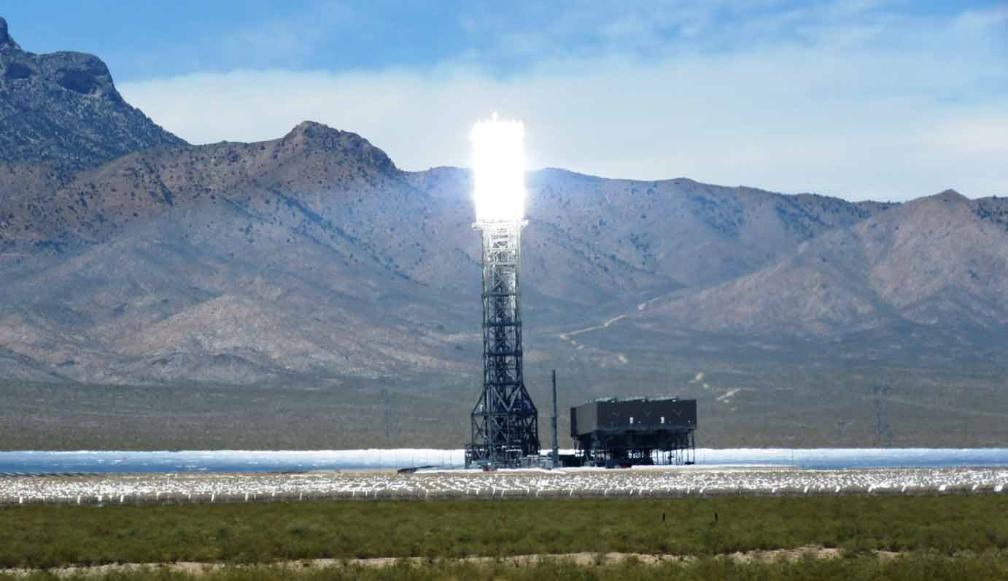
On May 25, 2017, after I finished touring Valley of Fire, Zion National Park and Bryce Canyon National Park
and was driving on Interstate Highway I-15 to go from Las Vegas to California, I saw that the Central Tower of
the Ivanpah Solar Electric Generating System is operational and is shinning brightly as hundred of thousands of
sun-tracking mirrors on the ground are reflecting and focusing huge amount of solar power on a receiver-boiler
filled with water that sits atop this tower. The water inside the receiver-boiler is heated and creates high
temperature steam. The steam is then piped to drive a turbine on the ground to generate electricity. During
operation, the three receiver units become extremely hot, such that they glow and appear brightly lit.
and was driving on Interstate Highway I-15 to go from Las Vegas to California, I saw that the Central Tower of
the Ivanpah Solar Electric Generating System is operational and is shinning brightly as hundred of thousands of
sun-tracking mirrors on the ground are reflecting and focusing huge amount of solar power on a receiver-boiler
filled with water that sits atop this tower. The water inside the receiver-boiler is heated and creates high
temperature steam. The steam is then piped to drive a turbine on the ground to generate electricity. During
operation, the three receiver units become extremely hot, such that they glow and appear brightly lit.

Three operational shinning towers of the Ivanpah Solar-Thermal Electric Generating System as viewed from
I-15. The three shinning towers are at substantial distances away from I-15. The 65X optical zoom of my
camera enabled me to zoom in to get the close up views of these towers in the pictures shown above.
I-15. The three shinning towers are at substantial distances away from I-15. The 65X optical zoom of my
camera enabled me to zoom in to get the close up views of these towers in the pictures shown above.

Hundreds of thousands of sun-tracking mirrors on the ground of the Ivanpah Solar Electric Generating System
sprawling across roughly 5 square miles of federal land near the California-Nevada border. Each mirror is
about the size of a garage door.
This huge facility formally opened supplying power on February 13, 2014, and it was the world's largest solar
thermal power station as of 2014. The plant has a gross capacity of 392 megawatts (MW). It deploys 173,500
sun-tracking mirrors known as heliostats.
The project was developed by BrightSource Energy and Bechtel. It costs $2.2 billion; the largest investor in the
project is NRG Energy, a power generating company based in Princeton, New Jersey, that has contributed
$300 million. Google has contributed $168 million, the U.S. Government provided a $1.6 billion loan guarantee,
and the plant is built on 4,000 acres of public land on the Mojave Desert with lots of sun shine.
Very impressive aerial views of the Ivanpah Solar Electric Generating System can be seen at the following
websites:
http://wilderness.org/world%E2%80%99s-largest-solar-plant-go-live-california%E2%80%99s-mojave-desert
http://www.zdnet.com/article/google-cans-solar-energy-project/
But in November 2011, Google announced that they would no longer invest in Solar-Thermal technology due to
the rapid price decline of photovoltaic solar systems, and stopped its research on the solar-thermal project.
However, an even larger solar-thermal system (Rio Mesa project, 750 megawatts of power) is being built on
5,750 acres about 13 miles southwest of Blythe near Interstate Highway I-10 in southern California. This time,
BrightSource will use higher towers, which should allow it to pack more of its sun-tracking mirrors into a
smaller area. It also will use a dry-cooling and water recycling system, which will use 90 percent less water
than competing solar thermal technologies with wet cooling. The design will use up to 33 percent less land than
a typical solar photovoltaic farm, the company says. In short, the goal is to produce the same power quality
using less land and water.
There are also other larger solar-thermal systems being built in other countries such as China, India, etc.
sprawling across roughly 5 square miles of federal land near the California-Nevada border. Each mirror is
about the size of a garage door.
This huge facility formally opened supplying power on February 13, 2014, and it was the world's largest solar
thermal power station as of 2014. The plant has a gross capacity of 392 megawatts (MW). It deploys 173,500
sun-tracking mirrors known as heliostats.
The project was developed by BrightSource Energy and Bechtel. It costs $2.2 billion; the largest investor in the
project is NRG Energy, a power generating company based in Princeton, New Jersey, that has contributed
$300 million. Google has contributed $168 million, the U.S. Government provided a $1.6 billion loan guarantee,
and the plant is built on 4,000 acres of public land on the Mojave Desert with lots of sun shine.
Very impressive aerial views of the Ivanpah Solar Electric Generating System can be seen at the following
websites:
http://wilderness.org/world%E2%80%99s-largest-solar-plant-go-live-california%E2%80%99s-mojave-desert
http://www.zdnet.com/article/google-cans-solar-energy-project/
But in November 2011, Google announced that they would no longer invest in Solar-Thermal technology due to
the rapid price decline of photovoltaic solar systems, and stopped its research on the solar-thermal project.
However, an even larger solar-thermal system (Rio Mesa project, 750 megawatts of power) is being built on
5,750 acres about 13 miles southwest of Blythe near Interstate Highway I-10 in southern California. This time,
BrightSource will use higher towers, which should allow it to pack more of its sun-tracking mirrors into a
smaller area. It also will use a dry-cooling and water recycling system, which will use 90 percent less water
than competing solar thermal technologies with wet cooling. The design will use up to 33 percent less land than
a typical solar photovoltaic farm, the company says. In short, the goal is to produce the same power quality
using less land and water.
There are also other larger solar-thermal systems being built in other countries such as China, India, etc.

One of several large fields/farms of Photovoltaic (PV) Solar panels in southern California.
On May 20 and 21, on our way of driving from California to Nevada and Utah to tour Valley of Fire, Zion
National Park and Bryce Canyon National Park, we also drove through areas of Antelope Valley California
Poppy Reserve near Lancaster in southern California. We saw several large farms of such Photovoltaic (PV)
Solar panels. Unfortunately, I was driving our rental car and could not take many pictures of all those huge
solar panel farms.
Since the price of PV solar panels decreases rapidly recently, solar energy generation is slowly becoming
price-competitive with conventional energy sources. Some other new technologies in research stage, such as
Graphene, may further improve the efficiency and the economy of PV solar power systems.
The Solar Star PV Power Plant slightly west of Rosamond in Antelope Valley, California went online with 579
MW of power in June 2015. When completed in June 2015, it was the world's largest solar farm in terms of
installed capacity, using 1.7 million PV solar panels, made by SunPower and spread over 13 square kilometers
(3,200 acres). The system positions the solar panels to track the sun during the day, increasing energy
capture by up to 25 percent. Aerial views of Solar Star Photovoltaic Power Plant can be seen at:
http://www.total.com/en/energy-expertise/projects/solar-power/solar-star-giant-photovoltaic-power-plant
https://www.mortenson.com/solar/projects/solar-star-i-and-ii
http://www.energy.ca.gov/tour/solarstar/
There are a number of other smaller PV solar plants nearby:
Antelope Valley Solar Ranch (266 MW from 3.8 million thin film panels)
Alpine Solar (66 MW AC, thin film panels)[5][6]
Catalina Solar Project (60 MW, thin film panels)
Map: Click here for Satellite View of interactive Google Map
that shows these farms of PV solar panels slightly west of Rosamond in Antelope Valley
Next time when we drive to this area again, I will let my friend do the driving, so that as a passenger, I can
take more pictures of such huge solar panel farms. We plan to come again in April to enjoy the huge field of
beautiful California poppy in addition to these huge farms of solar panels.
India has also installed a 648 MW solar panel farm in Kamuthi India. China has also installed 850 MW Dam
Solar Park with 4 million solar panels in Qinghai province, China. Satellite view of the huge Dam Solar Park in
China can be seen here.
On May 20 and 21, on our way of driving from California to Nevada and Utah to tour Valley of Fire, Zion
National Park and Bryce Canyon National Park, we also drove through areas of Antelope Valley California
Poppy Reserve near Lancaster in southern California. We saw several large farms of such Photovoltaic (PV)
Solar panels. Unfortunately, I was driving our rental car and could not take many pictures of all those huge
solar panel farms.
Since the price of PV solar panels decreases rapidly recently, solar energy generation is slowly becoming
price-competitive with conventional energy sources. Some other new technologies in research stage, such as
Graphene, may further improve the efficiency and the economy of PV solar power systems.
The Solar Star PV Power Plant slightly west of Rosamond in Antelope Valley, California went online with 579
MW of power in June 2015. When completed in June 2015, it was the world's largest solar farm in terms of
installed capacity, using 1.7 million PV solar panels, made by SunPower and spread over 13 square kilometers
(3,200 acres). The system positions the solar panels to track the sun during the day, increasing energy
capture by up to 25 percent. Aerial views of Solar Star Photovoltaic Power Plant can be seen at:
http://www.total.com/en/energy-expertise/projects/solar-power/solar-star-giant-photovoltaic-power-plant
https://www.mortenson.com/solar/projects/solar-star-i-and-ii
http://www.energy.ca.gov/tour/solarstar/
There are a number of other smaller PV solar plants nearby:
Antelope Valley Solar Ranch (266 MW from 3.8 million thin film panels)
Alpine Solar (66 MW AC, thin film panels)[5][6]
Catalina Solar Project (60 MW, thin film panels)
Map: Click here for Satellite View of interactive Google Map
that shows these farms of PV solar panels slightly west of Rosamond in Antelope Valley
Next time when we drive to this area again, I will let my friend do the driving, so that as a passenger, I can
take more pictures of such huge solar panel farms. We plan to come again in April to enjoy the huge field of
beautiful California poppy in addition to these huge farms of solar panels.
India has also installed a 648 MW solar panel farm in Kamuthi India. China has also installed 850 MW Dam
Solar Park with 4 million solar panels in Qinghai province, China. Satellite view of the huge Dam Solar Park in
China can be seen here.
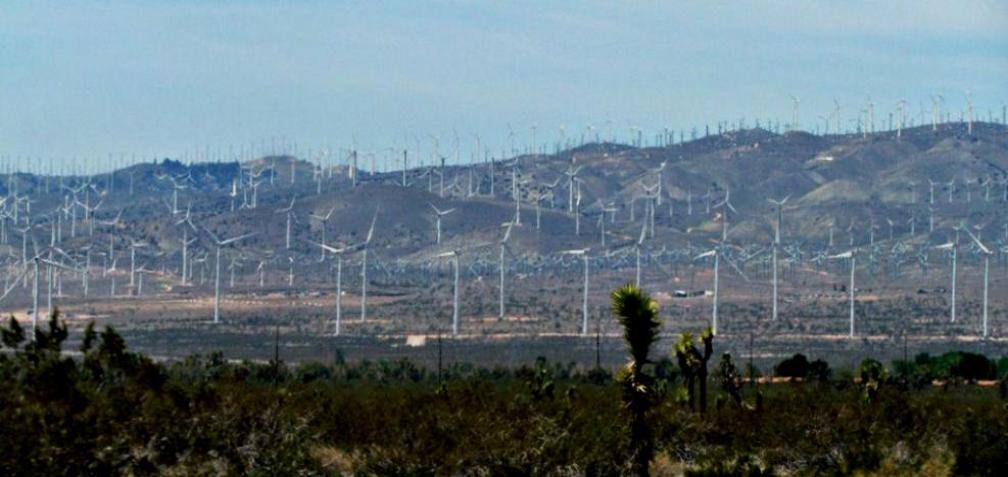
Two views of about 5,000 wind turbines on Tehachapi Pass on the scenic Tehachapi Mountains in Mojave
Desert in southern California. It is near the junction of Highway 58 and Tehachapi Willow Springs Rd east of
the town of Tehachapi and is about five miles West of town of Mojave which is at the junction of Highway 58
and Highway 14. The Tehachapi Pass is one of the windiest areas in the world.
The Tehachapi Wind Farm, is known as Alta Wind Energy Center (AWEC), also known as Mojave Wind Farm,
and is the largest in USA.
This huge forest of wind turbines has multiple generations of wind turbine technology installed since 1980s. An
aerial view of this large windmills farm can be seen at the following website:
http://www.shltrip.com/Rainbow_Basin.html
I zoomed in to take these two pictures of the huge forest of wind turbines at a substantial distance away when
we were at Antelope Valley California Poppy Reserve near Lancaster.
Desert in southern California. It is near the junction of Highway 58 and Tehachapi Willow Springs Rd east of
the town of Tehachapi and is about five miles West of town of Mojave which is at the junction of Highway 58
and Highway 14. The Tehachapi Pass is one of the windiest areas in the world.
The Tehachapi Wind Farm, is known as Alta Wind Energy Center (AWEC), also known as Mojave Wind Farm,
and is the largest in USA.
This huge forest of wind turbines has multiple generations of wind turbine technology installed since 1980s. An
aerial view of this large windmills farm can be seen at the following website:
http://www.shltrip.com/Rainbow_Basin.html
I zoomed in to take these two pictures of the huge forest of wind turbines at a substantial distance away when
we were at Antelope Valley California Poppy Reserve near Lancaster.

Another view of the Tehachapi Wind Farm as viewed remotely from Antelope Valley California Poppy
Reserve.
Reserve.
滿山遍野的橙色鮮花,十分爛漫。
The 579 MW Solar Star PV Power Plant slightly west of Rosamond in Antelope Valley, California is near the
huge area (1,760 acres) of beautiful California Poppy Reserve in Antelope Valley. A photo that I took of one
section of the huge area of brilliant orange colored California Poppy is sown above. I took this picture in early
April 2003 after we finished touring the Death Valley National Park and took a detour to visit the California
Poppy Reserve. It was gorgeous no matter which direction you look while standing in this huge field of
California poppy.
It was a very windy day with light rain when I took this picture in early April of 2003 such that some rain drops
on my camera lens caused some smudges on this picture.
The address of California Poppy Reserve is: 15101 Lancaster Road, Lancaster, CA 93536. Phone: (661) 946-
6092.
Directions: From the Antelope Valley Freeway (California 14) in Lancaster, exit on Avenue I and drive west 15
miles. Avenue I becomes Lancaster Road a few miles before the Poppy Reserve.
California poppy is California’s state flower. March through early May is the best time to enjoy the magnificent
display of desert wildflowers including the finest concentration of California’s state flower in this area of
Mojave Desert during a good wildflower year. However, not every year is a good wildflower year depending on
several factors in the whether. It is important for visitors to call (661) 724-1180 for recorded wildflower
updates information to see if it is a good year for desert wildflowers before you come here.
The 579 MW Solar Star PV Power Plant slightly west of Rosamond in Antelope Valley, California is near the
huge area (1,760 acres) of beautiful California Poppy Reserve in Antelope Valley. A photo that I took of one
section of the huge area of brilliant orange colored California Poppy is sown above. I took this picture in early
April 2003 after we finished touring the Death Valley National Park and took a detour to visit the California
Poppy Reserve. It was gorgeous no matter which direction you look while standing in this huge field of
California poppy.
It was a very windy day with light rain when I took this picture in early April of 2003 such that some rain drops
on my camera lens caused some smudges on this picture.
The address of California Poppy Reserve is: 15101 Lancaster Road, Lancaster, CA 93536. Phone: (661) 946-
6092.
Directions: From the Antelope Valley Freeway (California 14) in Lancaster, exit on Avenue I and drive west 15
miles. Avenue I becomes Lancaster Road a few miles before the Poppy Reserve.
California poppy is California’s state flower. March through early May is the best time to enjoy the magnificent
display of desert wildflowers including the finest concentration of California’s state flower in this area of
Mojave Desert during a good wildflower year. However, not every year is a good wildflower year depending on
several factors in the whether. It is important for visitors to call (661) 724-1180 for recorded wildflower
updates information to see if it is a good year for desert wildflowers before you come here.
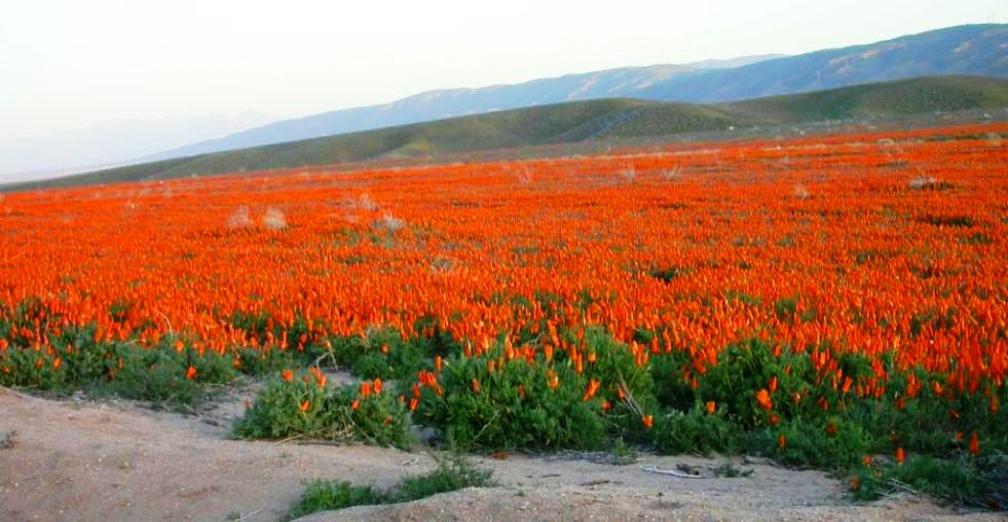
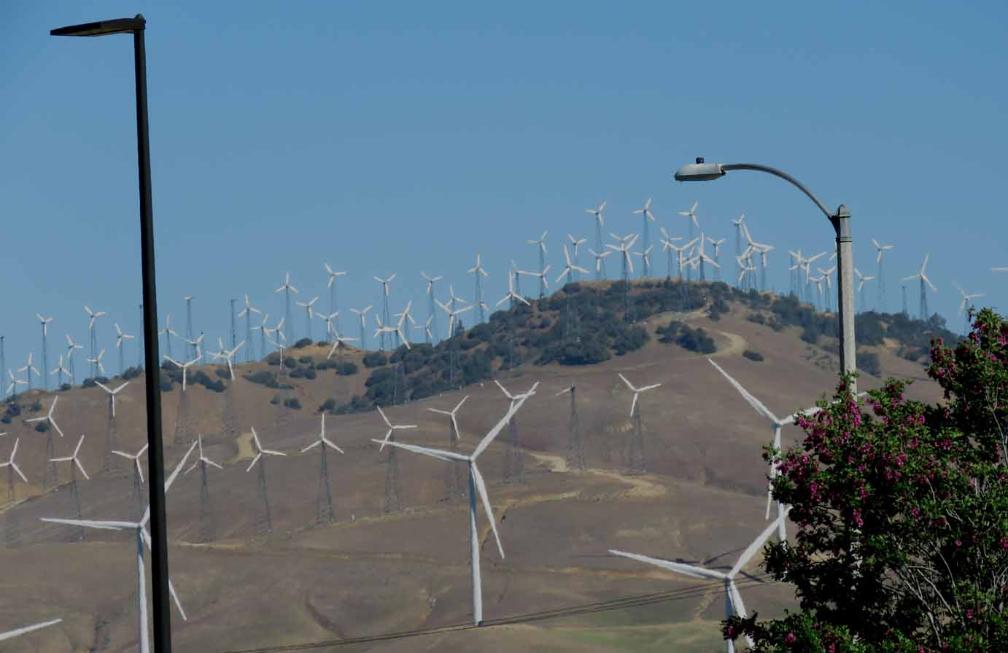
On May 21, 2017, when we drove from Lancaster going north on Highway 14 toward junction with Highway
58, we saw more wind turbines along Highway 14 and along Highway 58.
58, we saw more wind turbines along Highway 14 and along Highway 58.
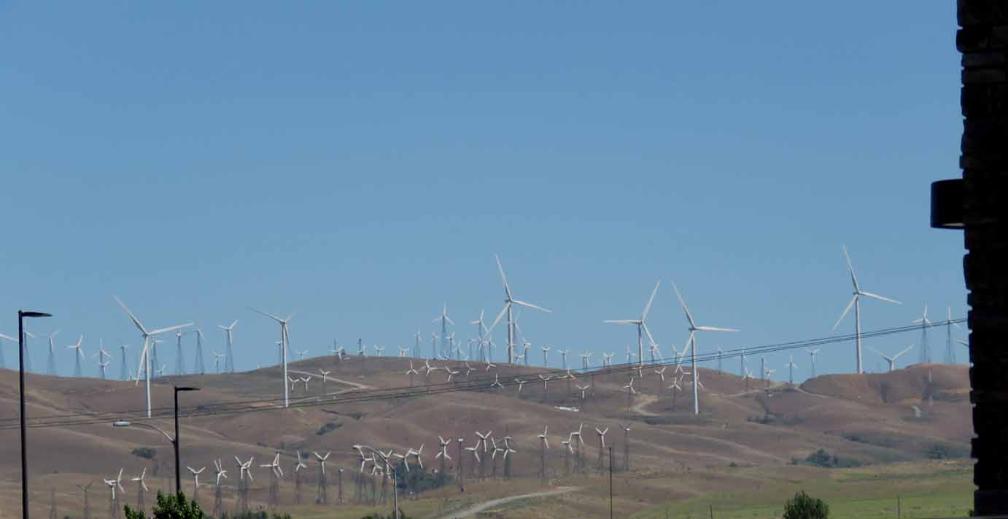
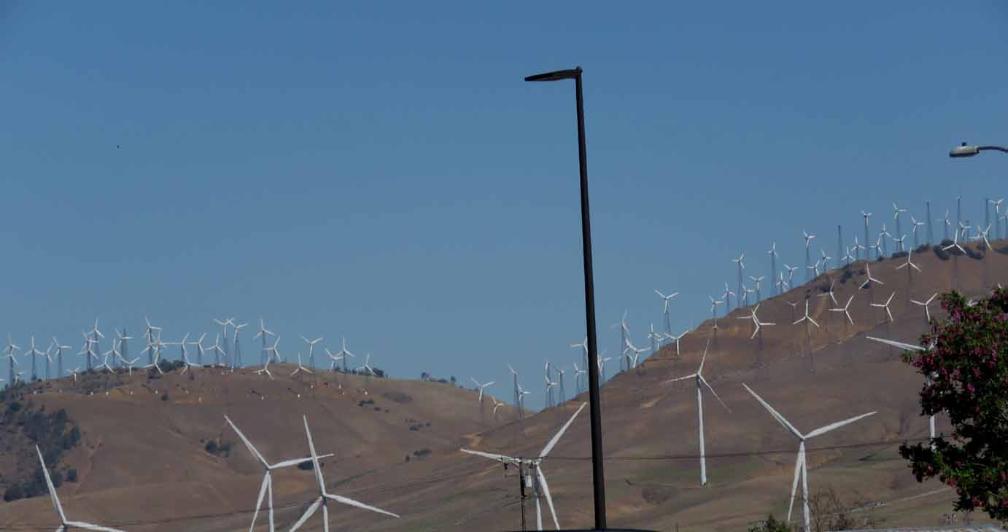
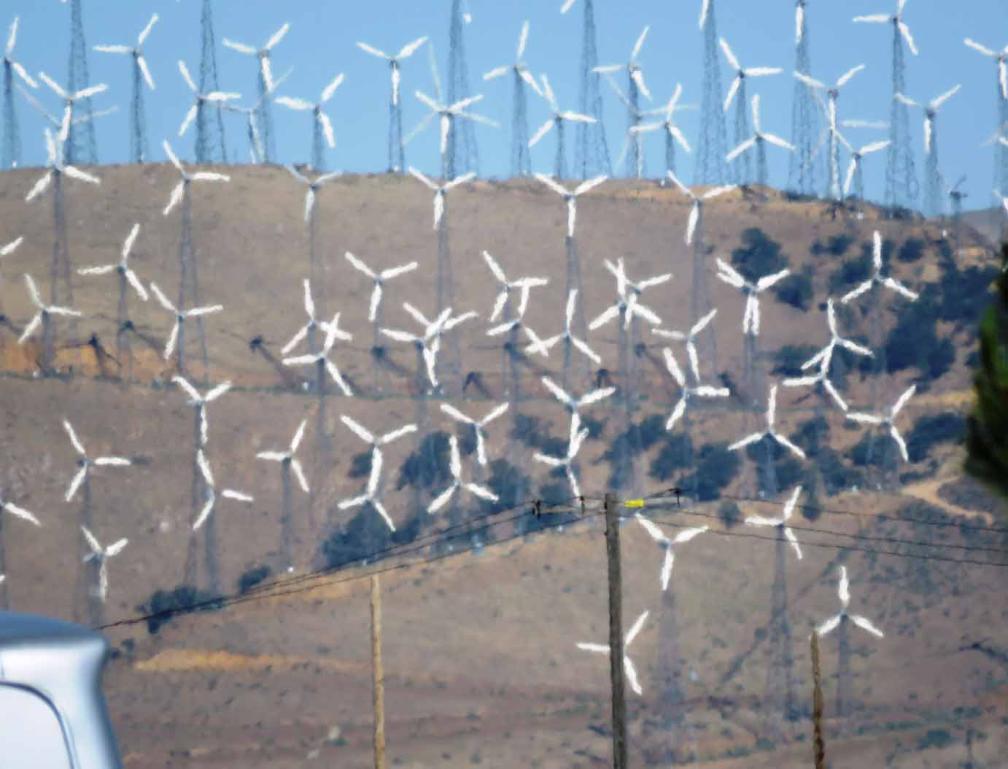
It just went on and on for miles and miles of seeing the huge array of wind turbines on Mojave Desert when
we drove on Highway 14 and on Highway 58.
we drove on Highway 14 and on Highway 58.



My camera has 65X optical zoom to enable me to zoom in on these wind turbines that are actually several
miles away from Highway 14.
miles away from Highway 14.

Note that many more wind turbines are on the mountain ridge far away.






Aerial views of parts of the large wind farm at Tehachapi Pass can be seen at:
http://clui.org/ludb/site/tehachapi-wind-farm
http://www.markholtzman.com/Energy/Wind/Alta-Wind-Energy-Center/i-9kBBckW
http://www.markholtzman.com/Energy/Wind/Alta-Wind-Energy-Center/i-C3CsJQT
http://clui.org/ludb/site/tehachapi-wind-farm
http://www.markholtzman.com/Energy/Wind/Alta-Wind-Energy-Center/i-9kBBckW
http://www.markholtzman.com/Energy/Wind/Alta-Wind-Energy-Center/i-C3CsJQT
Guided tours of the large wind farm near Palm Springs are available as shown on the following website:
https://www.tripadvisor.com/ShowUserReviews-g32847-d3979725-r463624650-The_Best_of_the_Best_Tours_Windmill_Tour-Palm_Springs_Greater_Palm_Springs_Califo.html
https://www.tripadvisor.com/ShowUserReviews-g32847-d3979725-r463624650-The_Best_of_the_Best_Tours_Windmill_Tour-Palm_Springs_Greater_Palm_Springs_Califo.html